I call it the Driveway Garden.
Not a bucolic name, nor was it, for many years, a particularly interesting garden. For most of the past twenty years, this garden was dominated by a hedge of Barbados Cherry, Malpighia glabra.
I let the Barbados Cherry grow and expand, tall and wide, because it’s a low maintenance shrub, blooms pretty pink flowers, develops luscious red fruits, provides cover for wildlife, and performs well in shade–a requirement for that spot. Additionally, it served as a privacy hedge and also as a stalwart plant bolstering against balls and bicycles when my children were young and there was roughhousing activity on and around the long driveway.
Aesthetically, it wasn’t ideal, but worked and was easy.
In recent years, the tree which shaded the garden began failing, so there is now more direct sun on the garden. I allowed myself the luxury of fantasizing about what plants I might add to the space to increase color, diversity, and wildlife interest to this otherwise utilitarian spot.
After the 2014-15 winter which was colder than any of the last twenty years, the Barbados Cherry froze to the ground and late last winter and early spring, I seized the opportunity to make changes to this narrow strip of garden. After its first year of remodeling, I’m generally pleased with the results. For reference, the driveway garden spans most of the length of the front drive, beginning at the street level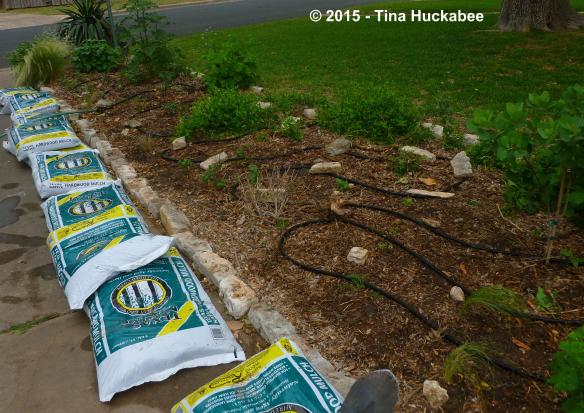
…and ending at the Green Tower (GT), a vertical structure which I’m experimenting with for vegetable and herb gardening.
I dug out the bits of Barbados Cherry root, big and small, shallow and deep, which filled in so much of the GT end of the garden. I left some of the shrubs,
…returning from winter freezes, which align alongside my property and the neighbor’s lawn. Vowing to keep those hardy and somewhat insidious limbs and roots in check, the goal is for the Barbados Cherry to act as individual, tidy, sometimes blooming, shrubs. I must ensure they don’t become the wall-of-plant they were and can certainly become again, if I’m not vigilant.
I also left the Turk’s Cap, Malvaviscus arboreus, which planted itself at the far end of the garden, just beside and around, the Green Tower.
Most of this garden re-do was accomplished with on-hand plants. When you grow natives, a vast supply of seedlings is at the ready for relocation to yours, or other gardens. I did buy a few plants though. In the vertical and horizontal center part of the garden, I added two purchased Red Yucca, Hesperaloe parviflora,
…and along the drive, purchased and planted three small pots of Four-nerve Daisy, Tetraneuris scaposa.
Close to the GT, I planted a Texas Smoke Tree, Cotinus obovatus, a tree I’ve long wanted to add to my garden.
Other plants that came from various parts of my gardens include Rock Rose, Pavonia lasiopetala, Purple Coneflower, Echinacea purpurea, Mexican Feathergrass, Nassella tenuissima, Globe Mallow, Sphaeralcea ambigua, Frostweed, Verbesina virginica, Goldeneye, Viguiera dentata, and a couple of white Tropical Sage, Salvia coccinea, which pop themselves all over my gardens with no assistance from me. Every spring I also allow some non-native, annual sunflowers (from birdseed, I think) to grow, bloom and seed-out and a few of those tall beauties always find their way into this garden. I transplanted (again!) a Gulf Muhly, Muhlenbergia capillaris,
…in hopes of autumn glory.
In October, a garden buddy gave me some Fall Obedient Plant, Physostegia virginiana, and it fills in a blank spot along the edge of the garden, by the neighbor’s turf.
After planting last spring, I added fresh mulch,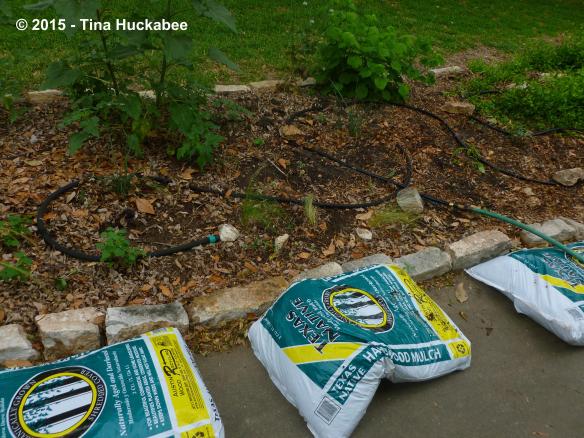
…and soaker hoses to the garden, with supervision from Asher the Garden Dog.
The Soft-leaf Yucca that I wrote about last post, anchored the street end of this garden. It’s snout-nosed weevil rotted and gone now, but the replacement Goldeneye will work beautifully in its stead.
I chose these particular plants because I’m a sucker for blooming things. Also, I wanted a variety of pollinator/seed-bearing plants for wildlife, for blooms, but also, for year-round interest with seeds and berries. The height of bloom time for the garden is summer through late fall.
The structural part of the garden resides in shrub form with the Barbados Cherry, Globe Mallow, and Rock Rose, and in a “grass” form by the Red Yucca, Mexican Feathergrass, and the foliage of the Four-nerve Daisy. The other plants are either dormant in winter or form small winter rosettes.
And though I don’t have many photos to verify, there was always insect and bird action around most of these plants.
The Green Tower was a limited success as a vertical vegetable garden. The top was lush with tomatoes, basil, cucumbers, and beans, but the sides were a bust–there wasn’t much vegetable growing success there, unfortunately. I moved three older Bougainvillea container plants from my back patio, where less sun smiles on them than in previous years and placed them on the driveway in front of the GT, which camouflaged the unplanned for bare wall of that structure.
The three Bougainvilleas were very happy in the new spot–they put on quite the show of blooms from midsummer until I moved them to the garage in November. I’m trying a different set of plants in the front and sides of the GT this year and that will require some integration with the potted Bougainvilleas.
Once the height of the growing season was past, the garden retained interest with seeds from the Frostweed, Goldeneye, and Coneflower and berries from the Barbados Cherry.
I’ll continue tweaking this garden–I’ve moved one Frostweed to another garden, lost the Yucca, but added Goldeneye. The Four-nerve Daisy seeded out, so there will be more happy yellow, low-growing daisies to fill in along one side. I’ve cleared out more of the Barbados Cherry, which will be an ongoing task, and I’m trying different plants (not vegetables) in the sides of the GT this year.
A year in the life of a garden. Mistakes, re-evaluations, and revelations mark the passage of time in gardening
What garden(s) are you looking at differently? Or changing in some fundamental way?

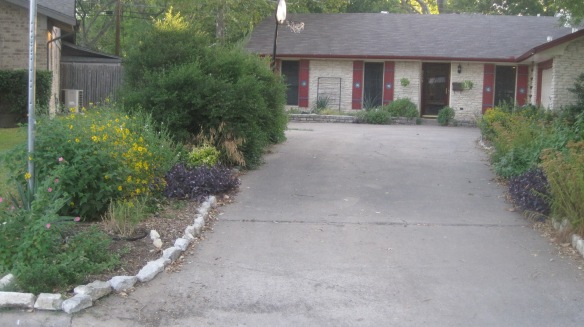
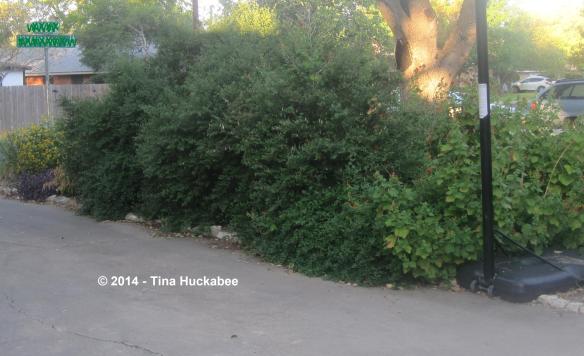
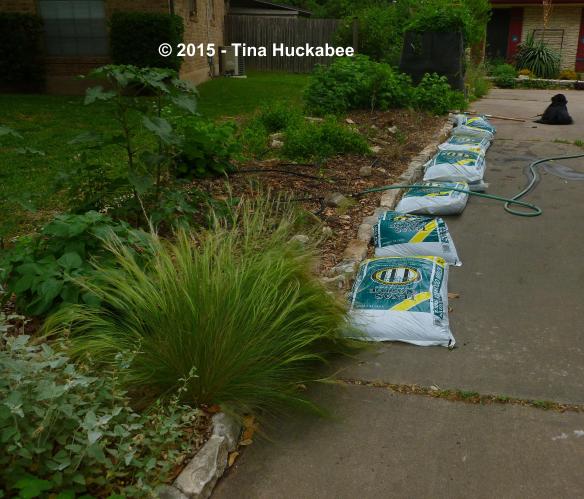
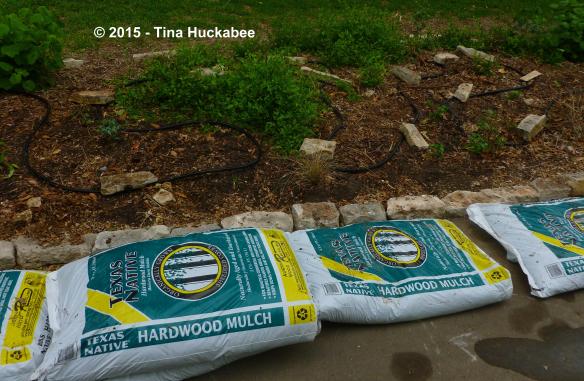
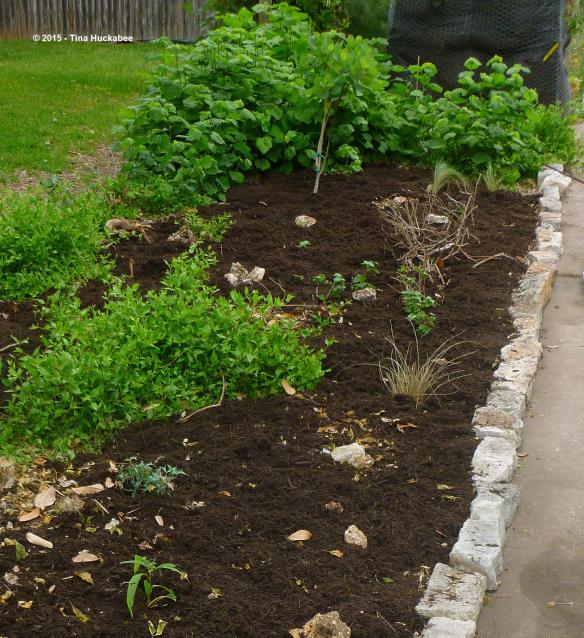
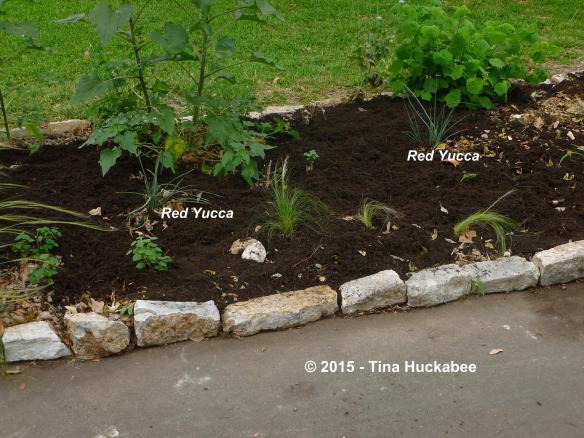
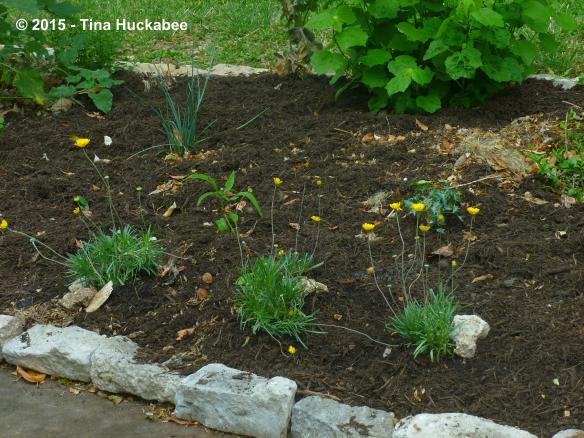
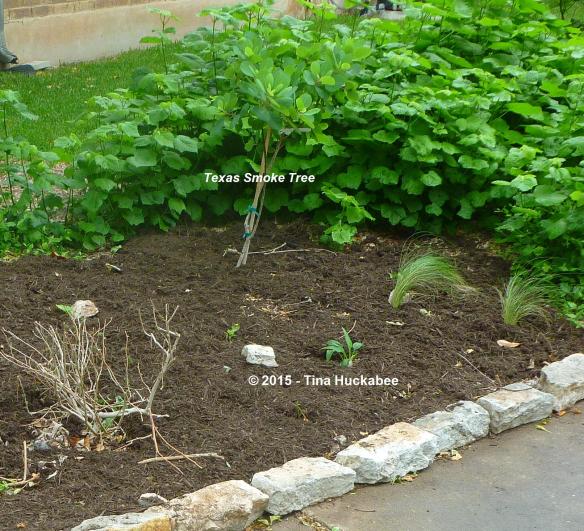
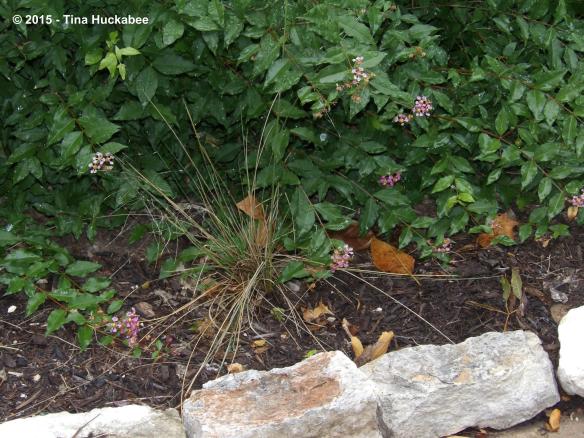
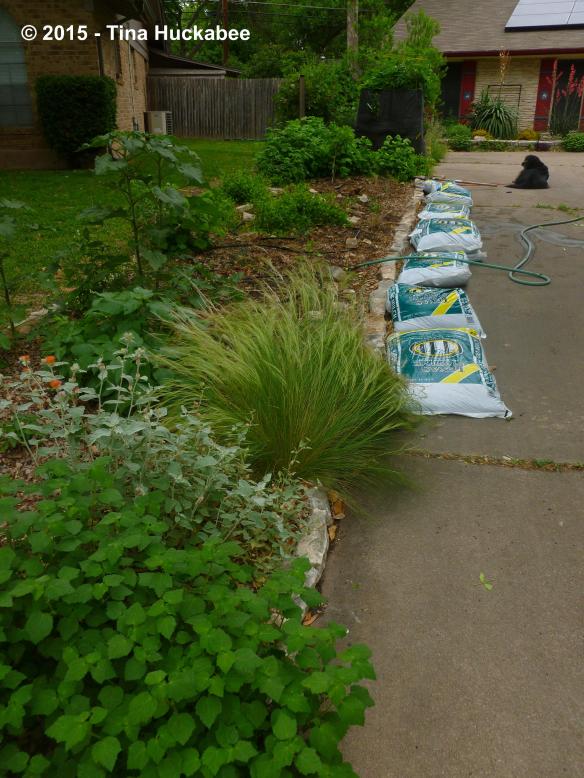
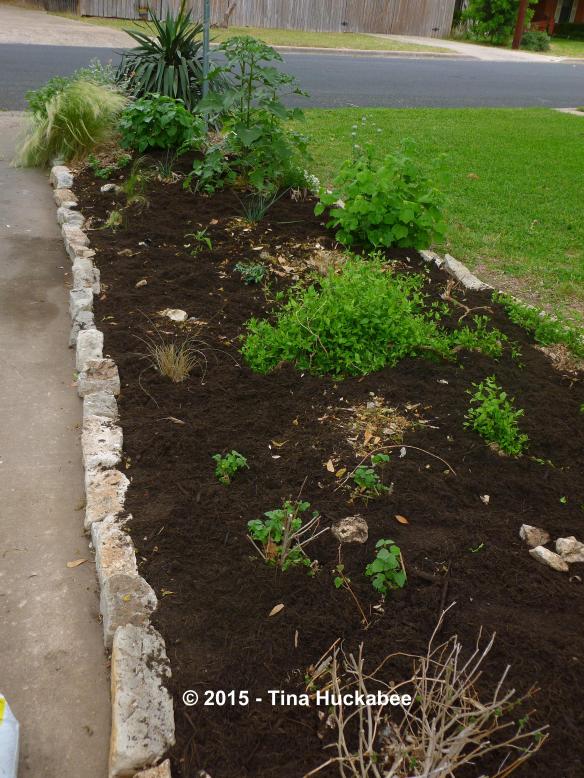
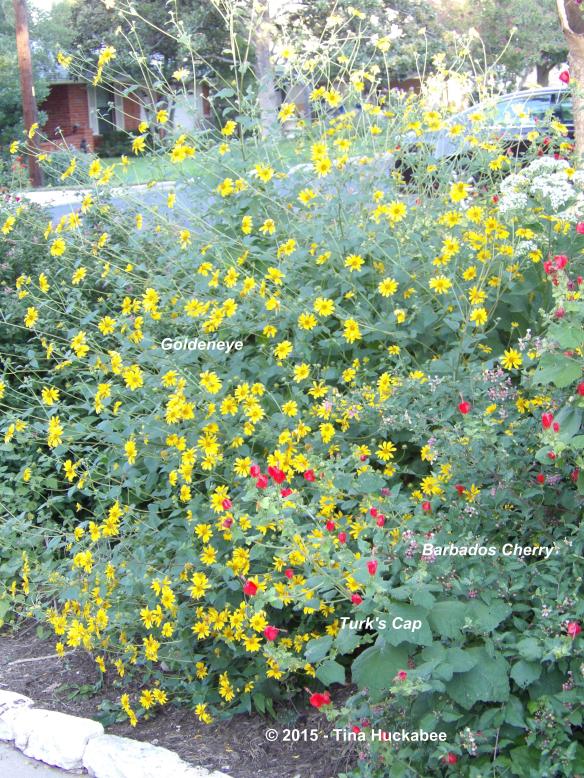
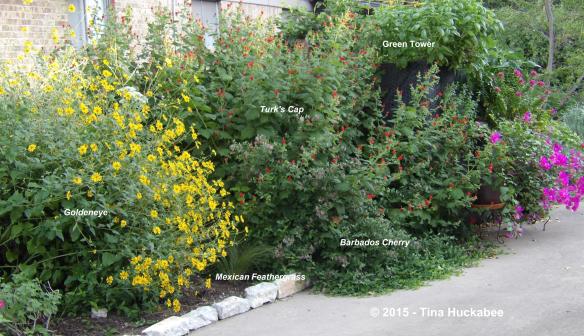
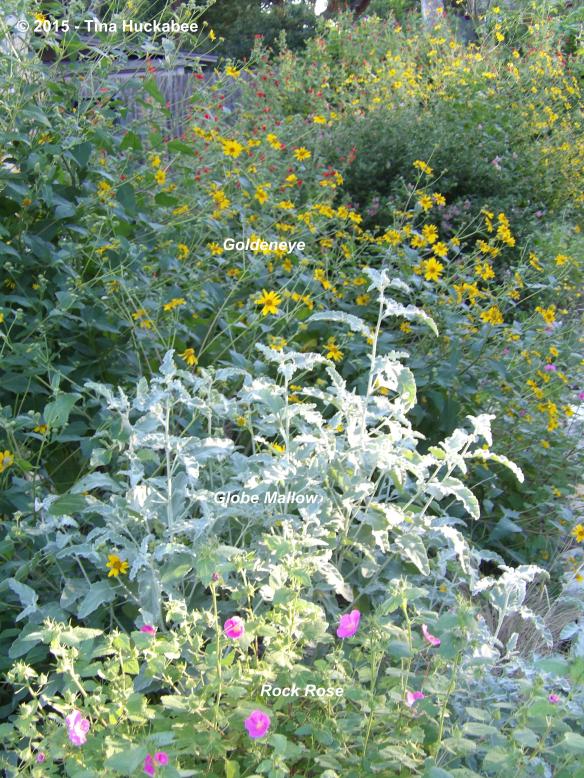
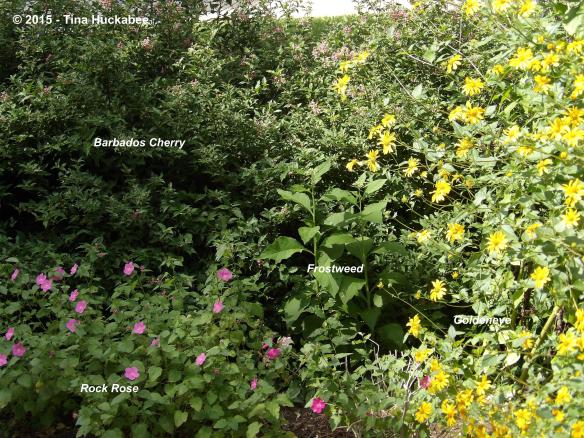
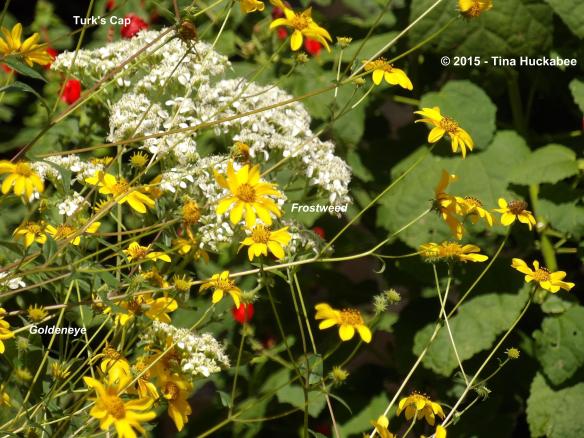
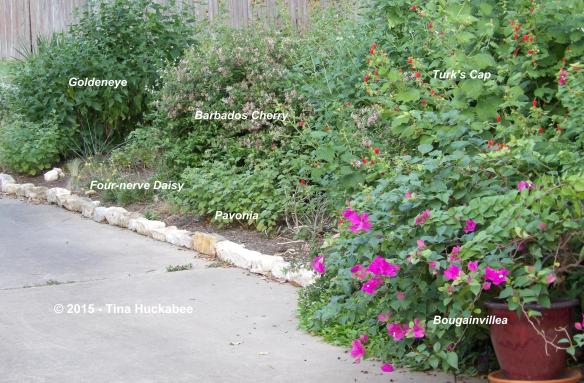
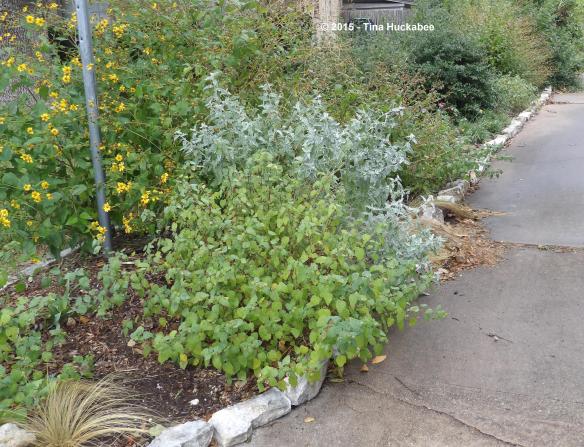
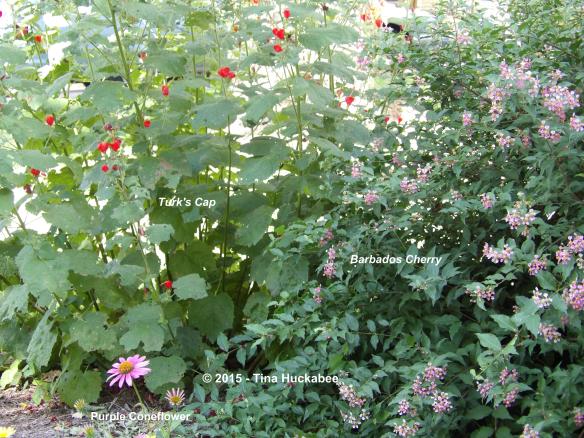
It looks wonderful!
LikeLike
Thanks! I’m pleased, though there are always things to fix, change and augment.
LikeLike
Over here every bed out back went up for grabs at some point a little over a year ago when I realized non-native plants had gobbled up much of my limited sun space. I’ve been methodically moving, sharing/downsizing non-native plantings, replacing them mostly with pollinator friendly flowering native perennials.
Quick question – what is your advice about the advisability of using mulch in beds where you want things to self reseed? Does the mulch layer get in the way, or do you open up areas under plants once they go to seed? I used to mulch everywhere every year, but more recently I left areas unmulched (though mostly covered by plant mass) in order to facilitate wildflower reseeding. Not sure I need to do that every year, and with tighter water restrictions in sight I am wondering if it is time to give everybody a nice cover-up before it gets hot again. Your thoughts?
LikeLike
To mulch or not to mulch, that is the question. Whether ’tis nobler….
Sorry, I got carried away. Here’s the funny thing: some plants produce seeds that just won’t break through mulch and others, well, they do. That Four-nerve daisy in the Driveway garden? Mulched out the wazoo and yet, there have been 10 seedlings which emerged this fall/winter which I then dutifully transplanted to spots that I preferred. On the other hand, I spread out poppy seeds every fall and this year, very few germinated where the mulch was thick.
I’m not very scientific–I might start something to observe its reaction, but then I get distracted by shiny things, and, well I forget. My advice would be to lightly mulch, or even better, spread out compost–those seeds will surely germinate! If you want to straddle the mulch fence, why not deeply mulch directly at the base of your established plants, then do the light mulch/compost thing where you think you want seeds.
Regardless, let me know how it turns out. I’ve just sort of let things happen in my gardens–what re-seeds I re-use, what doesn’t, I whine about. That seems to make me happiest. 🙂
LikeLike
What a fantastic job you did on this strip of garden, you must be so pleased with it. You had so much summer colour and I bet it was full of bees and insects.
LikeLike
Thanks so much, Chloris. I am happy with the garden. It was so colorful in the summer and the bees, butterflies and birds seemed to like it as well. I’d call that a win-win!
LikeLiked by 1 person
Ooof. I hit “post” too soon. I wanted to say – congratulations! Well done! That bed is gorgeous!
LikeLike
Awe thanks. It’s pretty, easy and the critters like it, so I’m happy.
LikeLike
What a wonderful job you’ve done. Also something I’ve been trying to work on for the last couple of years. Unfortunately we have a native live oak in one corner by the street that sends up shoots everywhere, so I have to work around that. I can only hope my areas eventually turn out to look even half as good as yours do. Your photos make me want to get out there right now but I know it’s a tad too early in this area. Any idea for shade-loving shrubs that can withstand at least 10F for under trees? Have fun!
LikeLike
Thanks! I know what you mean about those sprouts, they’re so hard to work around. I’m really fortunate, you know. My soil is fairly good, a bit on the heavy side, but good soil. I don’t have deer to contend with, so that’s real plus.
Have you tried columbines? I know that they look delicate, but they’re tough in cold and beautiful in shade. Also, the dwarf yaupon holly? Another plant that should withstand cold. It’s been a long time since Austin has had 10 degree and lower temps, plus, you’re so much further north. I bet if you contact your county extension agent/master gardener or master naturalist bunch that they could make suggestions to you. Wishing you good luck–write about what you come up with.
LikeLike
Thanks! I already have dwarf yaupon on my list. I’m also considering American Beauty Berry or some type of Agave. I’ll let you know what I eventually come up with. It could be totally different from what I’m currently thinking! I HAVE tried columbines but for some reason have had no luck at all with them.
LikeLike
It’s funny how some plant just won’t behave for one gardener and are totally on board for others. I can’t grow Mexican oregano or guara to save my life, but both are apparently easy to grow. For everyone else.
LikeLike
Oh, Tina. That is so beautiful! Everything works and fits together so nicely. Sucker for blooming things? If you can’t have flowers in Texas well what’s the point? The more I see that goldeneye the more I want to make a place for some. (Friendly wave to Asher the Garden Dog).
As for changes: this fall I have spread out a lot of leaves to kill turf. I’ve done this in two very large areas under my biggest trees. I’ve seen people do something like this with plastic (gasp) and cardboard but I am not in that much of a hurry. Next step is to add on some mulch this spring and just let it sit until fall. In the meantime I am looking for dry shade plants and my heart is breaking because there isn’t exactly a lot of choice. The native plants adapted for shade also were adapted for moist conditions. So mostly I have been pouring through databases trying to find stuff that will work and that I like.
LikeLike
Thank you, Debra. The goldeneye is just such a great plant–I’m quite besotted with it!
You’re wise to take your time. I don’t use plastic, nor have I tried the box thing, but I do use newspaper and it’s worked very well as a weed control and to kill out grass–which, come to think of it, is a weed as far as I’m concerned.
Turk’s Cap? Barbados Cherry? Those are both dry shade plants and do well for me without much bother. Also, chili pequin? If you don’t necessarily want to be a purist, I adore the giant liriope–it’s tough and graceful, as well as evergreen. You could also try the cultivar dwarf yaupon holly. The Texas sedge is really nice in shade as is the dwarf palmetto. I regret not planting palmetto years ago. It’s slow-growing (REALLY slow-growing), but I wished I would have planted some. I grew up in Corpus and had enough of palms, but I wish that I wouldn’t have had such a prejudice about them. Frostweed? I’ve seen those too in places that don’t get any water, but from the sky. Let us know what you decide–I’m interested.
LikeLike
These are great suggestions. ty ty ty I love the giant liriope and think it really adds to winter structure. We have hollies already in abundance. haha. I suppose there is always room for one more. I love the look of the chilis but they seem to be allergic to our pecans — at least that is my interpretation for their failure to thrive. I love dwarf palmetto and have seriously considered it. This might sound weird but I also like the prickly dewberry which has already planted itself here and there. Some other maybes: New Jersey Tea, Bluestar (?), woodland sunflower, the climbing prairie rose. I have dreams of the soil improving to the point where I could grow troutlily, wild onion, and wild phlox. Someday.
LikeLike
You know, Rock Rose can happen in dry shade–doesn’t bloom as much, but it’s a thing you might consider. Also, not evergreen, but the Salvia coccinea, whites and reds. And yarrow. I can give you both of those–I always got lots and lots. And lots. Anna of Transmutational Gardener also mentioned Beautyberry for her garden situation– don’t know how managed to forget about that one, as it’s a favorite of mine, but yeah, another.
How exciting!!
LikeLiked by 1 person
I love the constant change that comes with gardens and the opportunity to try new designs and plants is an exciting adventure. I love the variety of natives you have planted, with a variety of colors and textures that keep an interest in the space all year long. I recently purchased a Barbados Cherry, initially intending to plant it in my shade tree garden bed. But then after reading more about the massive size it can obtain (which is also evidenced by your post above), I’m now indecisive about the best location for it. I’ve nixed the idea of putting it in the shade tree bed, since I think it might overtake the area more than I prefer. It is now a toss up between a few other locations. My preferred option would be planting inside my fenceline – along the fence in a relatively shady spot where it would be in view of my backyard windows where I might be able to catch a glimpse of the birds that might frequent the bush for shelter and berries, however, I would need to keep the size in check in this area, not letting it get more than 5 feet wide and 10-15 feet long. Another option is outside my side fenceline, under some large shade trees that line the street. I could really let the plant grow to it’s max size here, but I wouldn’t see the plant or the wildlife it brings nearly as often. The final option would be on the shady side of the house, potentially to cover the bare wall and A/C unit that are not very attractive, but then again, I don’t go to that part of the yard often. How difficult do you think it would be to keep it maintained to a 5x10ft size? Or would you recommend planting it in a spot where it can grow ‘wild’?
LikeLike
I like Barbados Cherry very much–it’s tough and a great wildlife plant. Hmmm. It’s slow growing initially, so you won’t have to worry about it for a few years and I can’t answer how much you’d want to maintain it and I think that’s the real issue for you. I don’t think it would be that hard to maintain the size you’re looking at–5x10ft. Eventually, it’ll send out runners (of a sort) and you’ll need to whack those back a couple of times/year. The upside of one of the other areas is that you wouldn’t have to maintain it at all and it’d be there for the critters, which is one of your goals. I’d probably plant it to hide your AC–just make sure you give it room and that you keep it a bit of distance from the AC–you don’t want to deal with that as an issue in 5 or 6 years. Good luck!!
LikeLike
Looks great and I like how you reused existing plants to create a beautiful lush flowering garden in just one year.
LikeLike
Thanks, Shirley. We had a pretty good year with rainfall totals (in Austin proper) last year, so that helped the garden along. All of those plants are tried and true for my garden and I’m glad that I used them.
LikeLike
You’ve done a lovely job Tina and putting Goldeneye in where your Yukka was looks a great spot. I’ve looked some of your wonderfully named plants up as they were new to me, Four nerve Daisy is an especially interesting name.
LikeLike
Thank you, Julie. The goldeneye is a favorite of mine; I’m pleased to add it anywhere I can. Plant names are funny, aren’t they? I just love to read about how names are derived, though sometimes I don’t get how or why a particular name is given.
LikeLike
Being a novice gardener, I really enjoy these kinds of posts… Thank you… Michelle
LikeLike
Gosh, you’re so welcome. Thanks for reading!!
LikeLike
I like the results! These “before and after” posts are always entertaining and educational. It’s wonderful how you took advantage of the “die-off” to try some new things, and of the existing plant seedlings to start some new plants. Very nice.
LikeLike
Why thank you, Beth. I thought I’d better get in there, when the Barbados Cherry was down and out to take advantage, otherwise, it would be business as usual. I like to use my favorite plants, in different garden vignettes.
LikeLike
Your garden looks great! I love the redesign. The Mexican Feather Grass is a prolific reseeder. I’m always tweaking my designs to accommodate my ever expanding shade canopy. Gardens are always rough drafts, never final copies. 🙂
LikeLike
Thank you so much, Ms. Mariposa. I get lots of Mexican Feathergrass from reseeding–I’m glad for it.
You’re right about gardens–they are never finished, always a work in progress and would we want it any other way?
LikeLike
Pingback: All Hail Hymenoxys | My Gardener Says…